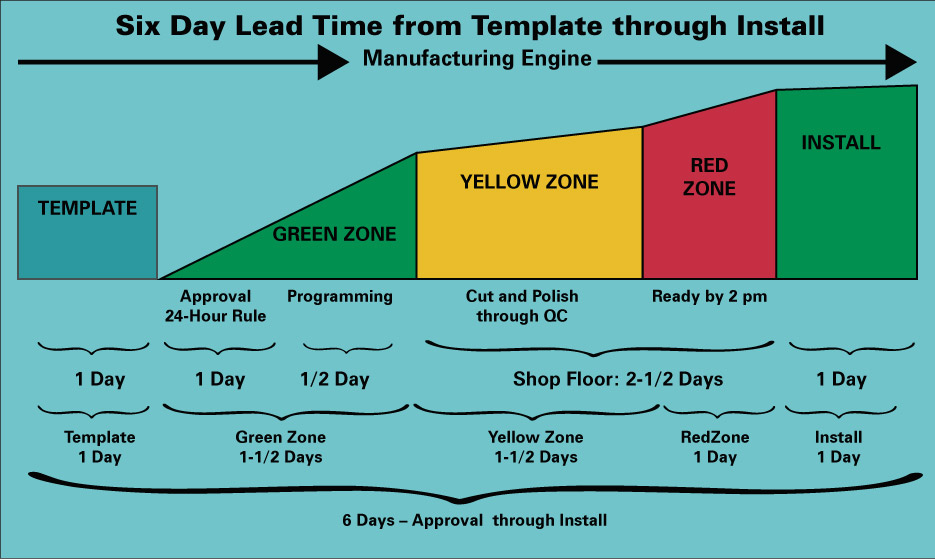What It Takes to Be a “10”
Ed Hill
Synchronous Solutions
Clients often ask me, “How are we doing? Are we on track? How do we compare to other companies who have done this?”
 They are referring to the practice of Synchronous Flow. They ask this upon completion of the initial implementation of the Synchronous Flow principles, when their score on a scale of ten would be about a three. And they continue to ask it as their use of the principles matures over the years. These people understand that Synchronous Flow is all about continuous improvement, so they are always looking for better ways to do business.
They are referring to the practice of Synchronous Flow. They ask this upon completion of the initial implementation of the Synchronous Flow principles, when their score on a scale of ten would be about a three. And they continue to ask it as their use of the principles matures over the years. These people understand that Synchronous Flow is all about continuous improvement, so they are always looking for better ways to do business.
They also understand that practicing Synchronous Flow is more a matter of behavioral discipline than just following a set of techniques. It is a new way to do business. It is a new language of operational control. Used most effectively, it can be a transformational journey in the operational performance of a company.
Synchronous Flow is a common sense approach to business management. The process flow is synchronized around a strategically selected Control Point, and all other functions work to serve that point. The primary metric is throughput ($T), which is the measure of value added by the company. Planning, scheduling and tracking the business is accomplished daily using $T as the common metric.
Protective buffers of orders-in-process are managed constantly to achieve a smooth flow of information and materials through the system from the sale through the completion of each order. The company uses the information from the various Synchronous Flow reports to identify and address the most advantageous opportunities for continuous improvement.
The driving philosophy of the organization should be that there are always opportunities to improve both financial and quality of life metrics for the company and its people. The degree to which a company practices those principles with diligence and discipline will define the performance of the operational system.
While the basic elements of Synchronous Flow can be implemented in a matter of months, the time frame from the initial introduction to a consistently good level of operational performance will probably be least one year. It takes that long to instill all the disciplines of the Synchronous Flow business process. Moreover, it takes that long to change the culture of the organization to one that follows the Synchronous Flow principles habitually as the basis for all routine procedures and decision-making. The driving principle of the business should be the capture of every opportunity for continuous improvement toward operational excellence.
To be scored a “10” would require excellence in all the principles of Synchronous Flow. Practice of these principles must be ingrained within the culture of the organization and must be habitual behaviors of its people.
Protective Capacity Planning
The Protective Capacity Plan (PCP) is the primary planning tool in Synchronous Flow. Kept up to date, it will coordinate the three most important elements of a business plan: (1) the projected market demand by product and market segment, (2) the internal operational capacity needed to meet that market demand and (3) the financial goals of the company.
Like a “three-legged stool,” adjusting any of the three will affect the other two. The objective is to balance those three elements of the business plan in order to optimize the realities of the projected business environment.
The PCP also indicates the $T and Productivity Score goals for the coming months. The Expense Control section indicates the status of the business relative to the desired financial goals and shows the effect of possible actions to bring the business into alignment with those goals.
An excellent Synchronous Flow company would keep the PCP current weekly with updates from sales and operations and would use it as a primary planning tool for the business. The PCP should serve as a “what if” analysis for any possible business scenario. The current status of the PCP is the first report on the agenda for the monthly Focus Meeting.
 |
|
Synchronous Flow production chart of a stone shop shows optimization of time and scheduling to build maximum efficiency. |
Finite Capacity Scheduling
The Control Point should be finitely scheduled to the amount of $T determined necessary to meet the projected market demand and to satisfy the financial goals of the company (from the PCP). The scheduling metric should be Throughput for the business system rather than common efficiency or unit metrics because $T is reflective of the operational labor content and is directly related to the financial goals of the company.
Each day should be “level-loaded” as closely as possible to the desired $T in each value stream. Level Loading is a primary principle of Synchronous Flow. It is recognized that a business system has finite (not infinite) capacity and that filling the available capacity to a reasonably consistent standard will achieve much better operational performance than a highly volatile mix of workload day to day. While overtime is an accepted method to address peaks in demand, excessive and constant overtime is recognized as ultimately destructive to the business system.
An excellent Synchronous Flow company would strive to “level-load” each value stream each day based on information from the PCP, and giving consideration to all known issues that would affect the timely process flow of orders.
$T Tracking
Knowing the amount of $T required to meet the daily demand at a given financial goal (from the PCP), the business should track the daily and cumulative monthly earning of $T by product and Control Point Team. This information, up to date with the previous day’s completions, should be reported at the morning Buffer Meeting. The business system must be structured to take definitive actions just as soon as the business begins to fall behind the cumulative goal in any month. Tracking and responding to the daily and cumulative status of $T earned relative to the goal will minimize any financial statement surprises at the end of the month.
An excellent Synchronous Flow company would review the $T Tracking Report, including the previous day’s completions, at each Buffer Meeting. Actions would be taken as soon as any metric is reported as behind the cumulative goal for the month. The report would be emailed daily to all Senior Management and an analysis of the trends would be reported at the monthly Focus Meeting.
 |
|
A Synchronized System Leads to Success |
Coordinated Release
Control the amount of WIP by issuing (releasing) new orders into the system based on the completion of orders from WIP. This information is summarized daily on the $T Tracking Report.
The concept is that less WIP is better, which will create a higher velocity of orders through the system.
An excellent Synchronous Flow company would understand that all information and materials for every released order should remain in motion until the order arrives in the Control Point Buffer. This company would understand that the true objective is the smooth flow of orders through the business system from the sale through completion of each order (line water through a pipe). Any stagnant inventory is a clear indication of a bottleneck and would be the target for immediate management action.
Protective Capacity
Maintain and manage the necessary levels of Protective Capacity at all non-constraint functions. The philosophy should be that Protective Capacity is necessary to absorb the normal variability of the business day. The amount of Protective Capacity necessary is a function of the normal variability experienced by the business system and can be posted on the PCP to drive the staffing calculations. Ideally, the operations portion of the business, including all support functions, should operate up to full capacity and with occasional (but not excessive) overtime at the prevailing market demand. Control of the operations for peaks or valleys of demand should be tested using the PCP for the most correct response.
An excellent Synchronous Flow company would understand that Protective Capacity is not excess capacity, but is essential capacity. This company would insist that the operations system should function within the identified parameters of work hours required as indicated on the PCP and would expect a quick response to any significant changes in projected market demand. Flexing the workforce, both up and down, should be a skill-set of management and the business system should be designed to accommodate this flexibility.
Buffer Management
Maintain and manage the Control Point Buffer and all feeding buffers at all times. Assuming a “level load” of $T each day, Operations Management should constantly manage the “health” of each buffer zone relative to the date and time each order should be in the Control Point Buffer. Hold Buffer Management meetings at least one time per shift identifying all the issues that have the potential to affect the performance at the Control Point. Responsibility assignments should be made for each issue identified. Follow-up, to assure complete accountability, should be accomplished at the next Buffer Management meeting (or before as necessary). The Buffer Management Log Book should be posted with a clear definition of each threat to healthy buffer status in each zone each day including the projected cause and the assignment of an owner for each issue. The objective of Buffer Management is the assurance that the desired $T can be earned every day of the month.
An excellent Synchronous Flow company would be driven by the Buffer Management concept in all of operations. This company would understand that having the right product in the right place at the right time is much more important than typical production efficiency metrics. The focus of Operations Managers should be maintaining the “health” of the buffers rather than just keeping the people busy.
Octane
The relative value of each hour of time at the Control Point is expressed as Octane. It is the measure of effectiveness at the company’s strategically selected point of focus. Any improvement in the performance of the Control Point will flow directly to the bottom line of the company. The daily Octane Report will reveal the true contribution to the organization from each product, customer, market segment, and many other selected areas of focus.
It will also indicate the most costly issues that affect the performance of the organization at the Control Point.
An excellent Synchronous Flow company would analyze the Octane Report weekly to identify and address actions toward any chronic issues affecting the Control Point. The Octane Report would be used to analyze the $T contribution for each customer, market segment and product line. Chronic issues attributable to any customer should be shared with that customer with the objective of working together to eliminate the causes. Progress reports should be made at the daily Buffer Meetings on any improvement projects underway. A report on Octane trends should be included in the monthly Focus Meeting.
Incentive Systems
Synchronous Flow provides an array of opportunities for employee incentive and profit share systems. Using $T as the primary metric and calculating the Productivity Score ($T divided by $OE), the incentive payouts can be designed to take affect only when the company has earned its desired levels of financial performance. The payout can be linked to any number of performance goals.
An excellent Synchronous Flow company would utilize the Productivity Score as a motivating factor for the workforce and would link incentive payouts to the achievement of performance goals.
Focus Meeting
The Focus Meeting is the point at which all of the elements of Synchronous Flow come together to form a holistic view of business operations. The objective is the identification of the greatest opportunities to improve company performance and quality of life for its people. The Focus Meeting is held monthly to formally review the status of the company relative to its goals in Net Profit, Lead Time, Customer Service and Continuous Improvement initiatives. At one point and at one time, all strategic and tactical circumstances of the organization should be brought to focus at one meeting, which is attended by the company’s leadership team and members of ownership. The primary objective of the Focus Meeting is to come away with several clearly identified opportunities for significant improvement in business performance and quality of life. The test for effectiveness of the Focus Meeting is the elimination of the issues identified for performance improvement initiatives.
An excellent Synchronous Flow company would use the Focus Meeting as a rally for continuous improvement within the company toward both financial performance and quality of life for all the company’s people. A world class organization is one that thrives on continuous improvement. The attitude of the business leaders should be excitement at the opportunity to address opportunities for performance improvement.
In the final analysis, the answer to the “How are we doing?” question rests with the owners of the organization. Ultimately, the degree to which the business is achieving the goals of the owners will determine the “score” of the operations system. How the company is doing toward meeting all the goals of the owners is the most important question. That would include excellent financial performance, a good return on the investments and a distinguished quality of life for all the stakeholders of the company. It could also include the chance to build a business of growing value to pass on to the next generation or to sell for retirement income. Or any number of other ownership goals.
The point, as emphasized in The Goal by Dr. Eli Goldratt, is every question about business performance should be measured against an established and clearly communicated set of goals. Performance to goals should be the driving focus of daily management. New goals should be set every month at the Focus Meeting with specific assignments to address the most advantageous opportunities. These concepts must be within the culture of the organization and should be a way of life for its people. Once that is consistently the case, the company could earn an excellent performance score.
Ed Hill is President of Synchronous Solutions and is based in Charlotte, North Carolina. He can be reached at EdHill@SynchronousSolutions.com and at 704-560-1536.to identify and address the most advantageous opportunities for continuous improvement.